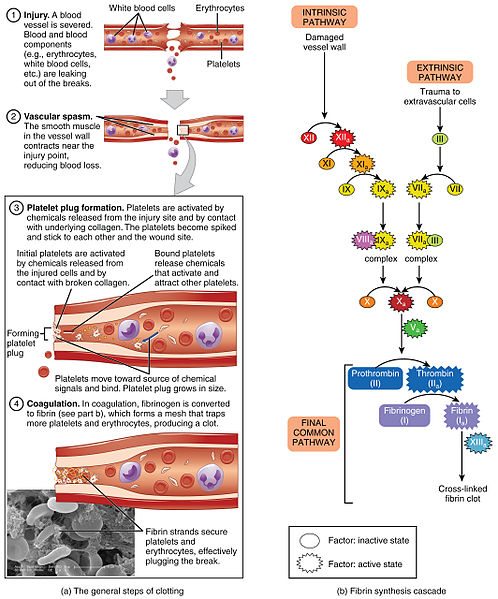10.5 Physiology of the Hematology System
Functions of Blood
The primary functions of blood are the transportation of oxygen, carbon dioxide, nutrients, and hormones, as well as moving cellular wastes so they can be eliminated from the body. Other functions of blood include thermoregulation, defense against infection, and hemostasis.[1]
Transportation
The blood transports oxygen, carbon dioxide, nutrients, electrolytes, and hormones. Oxygen from the air you breathe diffuses into the blood in the lungs and then moves to the heart where it is pumped out to the tissues of the body. From the tissues, blood picks up carbon dioxide and moves it to the lungs for removal by exhalation.
Nutrients from the foods you eat are absorbed in the digestive tract. Most of these travel in the bloodstream to the liver, where they are metabolized and released back into the bloodstream for delivery to body cells. Various waste products are also picked up from the cells in the blood and then transported to the kidneys and liver for excretion from the body in the form of urine or bile.
Finally, endocrine glands scattered throughout the body release hormones into the bloodstream, where they are transported to distant target cells they affect.
Thermoregulation
Body temperature is regulated via a negative-feedback loop referred to as thermoregulation. For example, if you exercise on a hot day, your rising core body temperature triggers several mechanisms, including the increased transportation of blood from your core to the surface of your body, which is typically cooler. As blood passes through the vessels of the skin, heat is dissipated to the environment, and the blood returning to your core is cooler. In contrast, on a cold day, blood is diverted away from the skin to maintain a warm core. In extreme cold, if the extremities are not protected adequately, this process can result in frostbite.
Defense Against Infection
Many types of WBCs protect the body from infection by microorganisms that enter the body. Other WBCs seek out and destroy internal threats, such as cells with mutated DNA that could multiply to become cancerous. Read more about the function of WBCs in the “Lymphatic and Immune Systems Terminology” chapter.
Hemostasis
When damage occurs to blood vessels that results in bleeding, platelets and clotting factors form a clot to stop the bleeding, referred to as hemostasis (hē-mō-STĀ-sĭs). There are three steps to the hemostasis process: vascular spasm called vasoconstriction, the formation of a platelet plug, and blood clotting called coagulation (kō-ag-yū-LĀ-shŏn). Failure of any of these steps will result in hemorrhage. Figure 10.8[2] summarizes the steps of hemostasis.

During hemostasis, a protein called fibrin (FĪ-brin) is produced to form a blood clot.
Fibrinolysis (fī-brĭ-NŌL-ĭ-sĭs) is the process in which a clot is degraded in a healing vessel. An anticoagulant (an-tī-kō-AG-yū-lănt) is a substance or medication that prevents coagulation. Examples of commonly prescribed anticoagulant medications are warfarin and heparin.
Three commonly performed blood tests related to blood clotting are prothrombin time (PRŌ-thrŏm-bĭn tīm) (PT), international normalized ratio (ĭn-tĕr-NASH-ŭ-năl NÔR-mă-līzd RĀ-shiō) (INR), and partial thromboplastin time (pär-shăl thrŏm-bō-PLAS-tĭn tīm) (PTT). PT measures the time it takes for plasma to clot. INR is a standardized measurement of PT, so a normal reference range can be used for all individuals. PTT measures a specific group of clotting factors. These tests may be performed to diagnose clotting disorders or monitor patients who are receiving anticoagulants.[3]
- This work is a derivative of Anatomy & Physiology by OpenStax and is licensed under CC BY 4.0. Access for free at https://openstax.org/details/books/anatomy-and-physiology-2e ↵
- “1909_Blood_Clotting.jpg” by OpenStax College is licensed under CC BY 3.0 ↵
- MedlinePlus [Internet]. Bethesda (MD): National Library of Medicine (US); [updated 2022, Sep. 21]. Prothrombin time test and INR (PT/INR); [cited 2023, Nov. 5]. https://medlineplus.gov/lab-tests/prothrombin-time-test-and-inr-ptinr/ ↵

